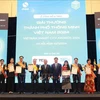Hanoi (VNA) - Vietnam has been striving to improve its legal framework and policies on science and technology in order to boost productivity and economic competitiveness and make innovation a driver of growth.
A total of 16 governmental and seven ministerial documents were issued last year to enhance financial mechanisms for the development of science and technology, particularly on mobilising non-State budget capital and attracting a skilled workforce.
Vietnam is now home to 687 organisations conducting science and technology studies, 236 universities, three high-tech parks, 13 high-tech agricultural zones, and eight information technology (IT) parks.
The country has spent 2 percent of its State budget annually on science and technology. Infrastructure for studies in key sub-sectors, including biotechnology, petro-chemistry, materials, energy, automation, nanotechnology, computational technology, and medicine have also seen substantial investments.
It ranked 42nd among 131 economies for the second consecutive year in the 2020 Global Innovation Index (GII). Among economies making the most significant progress in their GII innovation rankings over time, Vietnam was first among 29 lower middle-income countries and third in Southeast Asia.
Compared to its own index in the previous year, it posted higher levels in a number of indicators, including business sophistication, rising from 69th to 39th place, and creative output, from 47th to 38th.
Vietnam has used the GII as an important management tool since 2017, with its index rising from 71st place in 2014 to 59th in 2016 and 42nd last year.
This year, the Ministry of Science and Technology will focus efforts on amending policies in financing and investing in science and technology development and innovation projects, in particular the draft of the revised Law on Intellectual Property./.
A total of 16 governmental and seven ministerial documents were issued last year to enhance financial mechanisms for the development of science and technology, particularly on mobilising non-State budget capital and attracting a skilled workforce.
Vietnam is now home to 687 organisations conducting science and technology studies, 236 universities, three high-tech parks, 13 high-tech agricultural zones, and eight information technology (IT) parks.
The country has spent 2 percent of its State budget annually on science and technology. Infrastructure for studies in key sub-sectors, including biotechnology, petro-chemistry, materials, energy, automation, nanotechnology, computational technology, and medicine have also seen substantial investments.
It ranked 42nd among 131 economies for the second consecutive year in the 2020 Global Innovation Index (GII). Among economies making the most significant progress in their GII innovation rankings over time, Vietnam was first among 29 lower middle-income countries and third in Southeast Asia.
Compared to its own index in the previous year, it posted higher levels in a number of indicators, including business sophistication, rising from 69th to 39th place, and creative output, from 47th to 38th.
Vietnam has used the GII as an important management tool since 2017, with its index rising from 71st place in 2014 to 59th in 2016 and 42nd last year.
This year, the Ministry of Science and Technology will focus efforts on amending policies in financing and investing in science and technology development and innovation projects, in particular the draft of the revised Law on Intellectual Property./.
VNA
























